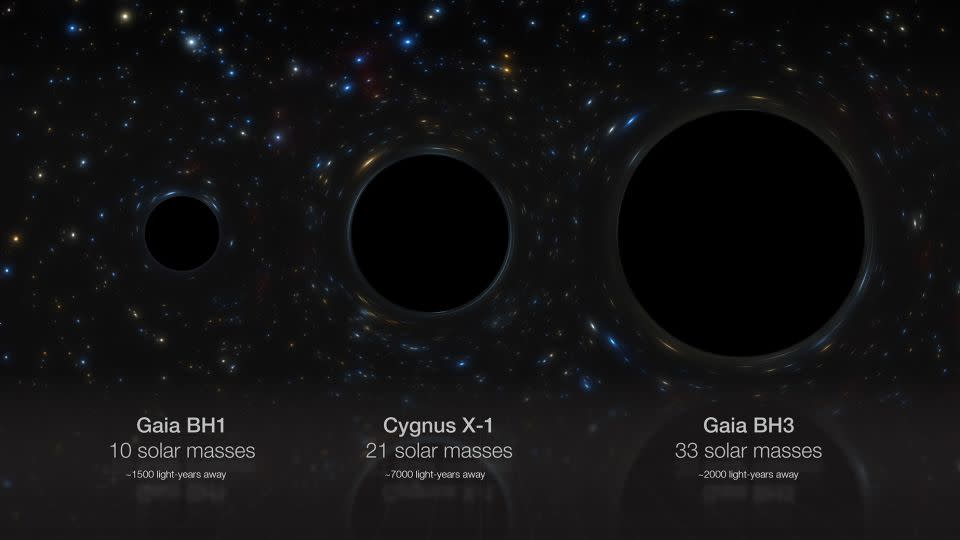Sign up for CNN’s Wonder Theory science newsletter. Explore the universe with news about fascinating discoveries, scientific breakthroughs and more.
Astronomers have spotted the most massive known stellar black hole in the Milky Way after detecting an unusual wobble in space.
The so-called “sleeping giant”, called Gaia BH3, has a mass almost 33 times that of our Sun and is located 1,926 light-years away, in the constellation Aquila, making it the second closest known black hole. from the earth. . The closest black hole is Gaia BH1, located about 1,500 light-years away and has a mass almost 10 times that of our Sun.
Astronomers discovered the black hole while combing through observations made by the European Space Agency’s Gaia space telescope for an upcoming release of data to the scientific community. Researchers didn’t expect to find anything, but a peculiar movement — caused by Gaia BH3’s gravitational influence on a nearby companion — caught their attention.
Many “sleeping” black holes don’t have a companion close enough to munch on, so they’re much harder to detect and don’t generate light. But other stellar black holes suck in material from companion stars, and this exchange of matter releases bright X-rays that can be observed through telescopes.
The wobbling motion of an old giant star in the constellation Aquila revealed that it was in an orbital dance with a dormant black hole, and is the third dormant black hole spotted by Gaia.
Researchers used the European Southern Observatory’s Very Large Telescope in Chile’s Atacama Desert and other ground-based observatories to confirm the mass of Gaia BH3, and their study also offered new clues about how these enormous black holes came to be. The findings appeared Tuesday in the journal Astronomy and Astrophysics.
“No one expected to find a massive black hole lurking nearby, undetected until now,” said study lead author Pasquale Panuzzo, an astronomer at the Observatoire de Paris, part of France’s National Center for Scientific Research, and a member of the Gaia collaboration. , in a statement. “This is the kind of discovery you make once in your research life.”
The secrets of ancient stars
The title of most massive black hole in our galaxy will always belong to Sagittarius A*, the supermassive black hole located at the center of the Milky Way, which is about 4 million times the mass of the Sun, but that’s because it’s a supermassive black hole. , rather than a stellar black hole.
The process by which supermassive black holes form is poorly understood, but one theory suggests that it happens when huge cosmic clouds collapse. Stellar black holes form when massive stars die. Therefore, Gaia BH3 is the most massive black hole in our galaxy that formed from the death of a massive star.
Stellar black holes observed throughout the Milky Way are about 10 times more massive than the Sun, on average. Until the discovery of Gaia BH3, the largest known stellar black hole in our galaxy was Cygnus X-1, which is 21 times the mass of the Sun. Although Gaia BH3 is an exceptional discovery in our galaxy by astronomers’ standards, it is similar in mass to objects found in very distant galaxies.

Scientists believe that stellar black holes with masses like Gaia BH3 formed when metal-poor stars collapsed. These stars, which include hydrogen and helium as their heaviest elements, are thought to lose less mass over their lifetime, so they have more material at the end that could result in a massive black hole.
But astronomers couldn’t find evidence directly linking massive black holes and metal-poor stars until they found Gaia BH3.
The study authors said paired stars tend to have similar composition. True to expectations, the researchers found that the star orbiting Gaia BH3 was metal-poor, meaning the star that formed Gaia BH3 was likely the same.
“What strikes me is that the chemical composition of the companion is similar to what we find in ancient metal-poor stars in the galaxy,” study co-author Elisabetta Caffau, a member of the Gaia collaboration at the Paris Observatory, said in a statement.
The star orbiting Gaia BH3 probably formed within the first 2 billion years after the Big Bang created the Universe 13.8 billion years ago. The trajectory of the star, which moves in the opposite direction of many stars in the Milky Way’s galactic disk, suggests it was part of a small galaxy that merged with the Milky Way more than 8 billion years ago.
Now, the team hopes that the investigation can allow other astronomers to study the colossal black hole and discover more of its secrets without having to wait for the rest of Gaia’s data release, scheduled for late 2025.
“It is impressive to see the transformational impact that Gaia is having on astronomy and astrophysics,” said Carole Mundell, director of science at the European Space Agency, in a statement. “Their discoveries go far beyond the mission’s original purpose, which was to create an extraordinarily accurate multidimensional map of more than a billion stars across our Milky Way galaxy.”
For more news and newsletters from CNN, create an account at CNN.com





































